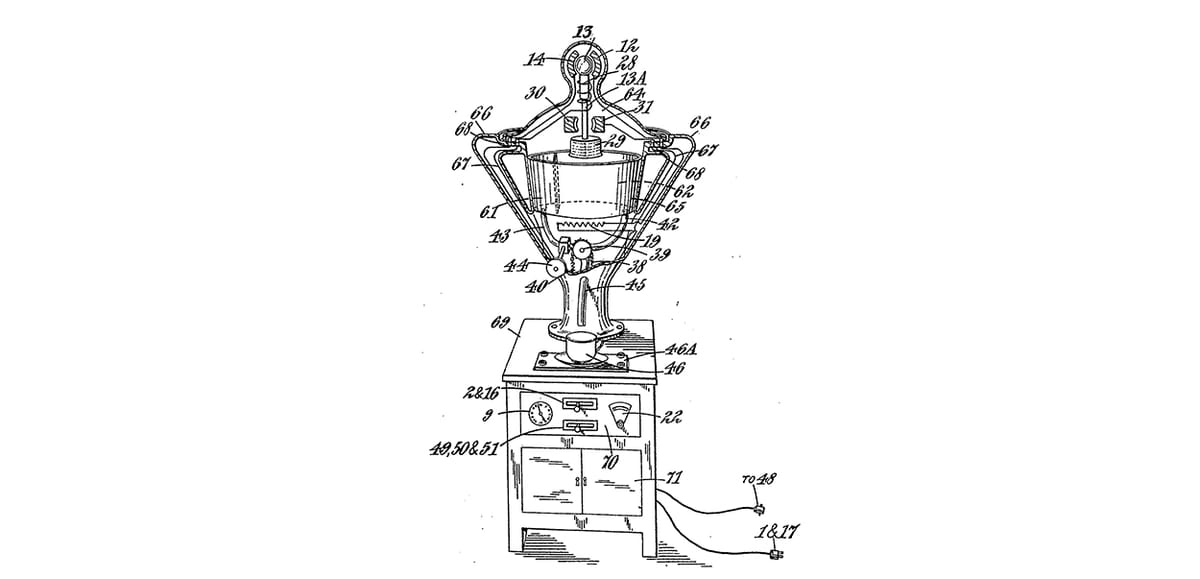1932 Bombay Radio Company teamaker

On November 22nd 1932 Mrs Joy Dorothy Virmani applied for a British Patent via Hatton Gardens patent agents Boult Wade and Tennant, for the largest teasmade I have ever seen! The application was on behalf of the Bombay Radio Company, then of 73-75 Marine Lines, opposite Marine Lines Station, Queen’s Road, Bombay, India. The Patent, number GB-396982-A, was for “Improvements in automatic apparatus for preparing hot beverages such as tea, coffee,cocoa and the like”.
VIRMANI, J D, c/o Bombay Radio Co Ltd, opposite Marine Lines Station, Bombay, India. Nov 22, 1932, No 33011. [Class 129.]
Apparatus for making tea, &c., at a predetermined time comprises two compartments, one for water and one for milk, an electric heater, a time switch and means for lowering the tea leaf, &c., container into the boiling water and for allowing the tea, &c., and milk to run together into a cup.
In operating the apparatus, the time switch 9 is set and the cup 46 placed on the platform 46a. The weight of the cup depresses the platform to make contact between 4, 6, as shown in the Figure. A wall plug 1, 17 is plugged into its socket and the double pole switch 2, 16 turned on. If it will be dark at the time the beverage is required, the switch 49 is thrown over to 50.; As the time switch 9 operates, the current is turned on passing from the lead 1 to the switch 2, the fuze 3, contacts 4, 6, time switch 7 to 10 and on through resistances 18, 19 and resistances 21, 20. The current returns through 11 to the contact 12, through the ballhead 13, to the contact 14, fuze 15, switch 16 and main plug 17.
When the resistance value of 18, 19 is equal to that of 21, 20, no current will flow between 25, 22. This bridge is set slightly out of balance by the arm 22 of the potentiometer 21, 22 so that a small current constantly passes through the resistance 23, 24. This current is insufficient to heat the element 26 but to bring it to almost a critical point at which it just starts bending so that if the temperature of the coil 23, 24 increases due to increased current, 26 will bend and make contact 27.; Resistance 19 is made of bismuth and forms the heater element of the container. As this resistance heats up, its resistance alters, disturbing the balance of the bridge and allowing more current to flow.
As soon as 26 touches 27, the current flows from 1 via 4, 6, 27, 26 to the solenoid 28 to cause the handle 13 to be jerked downwards to immerse the tea leaf in 29 into the boiling water. This breaks the electrical connection between 12, 14 to stop the current through the heater. When the container 29 drops into the boiling water, the ball-head 13 makes contact between the members 30, 31 to cause current to flow into the coil 32 to heat up the element 34 to make contact with 35 and so actuate the solenoid 36. This pulls the plunger 37 to turn the cock 41 against the spring 40 to deliver the tea and milk into.the cup 46. The quantity of milk is regulated by the valve 44.; As the cup fills, its weight causes 4 to make contact with the insulator 7, so breaking the contact 4, 6 and interrupting the flow of current. The member 4 goes a little beyond 7 to make contact 8 to ring a bell.
